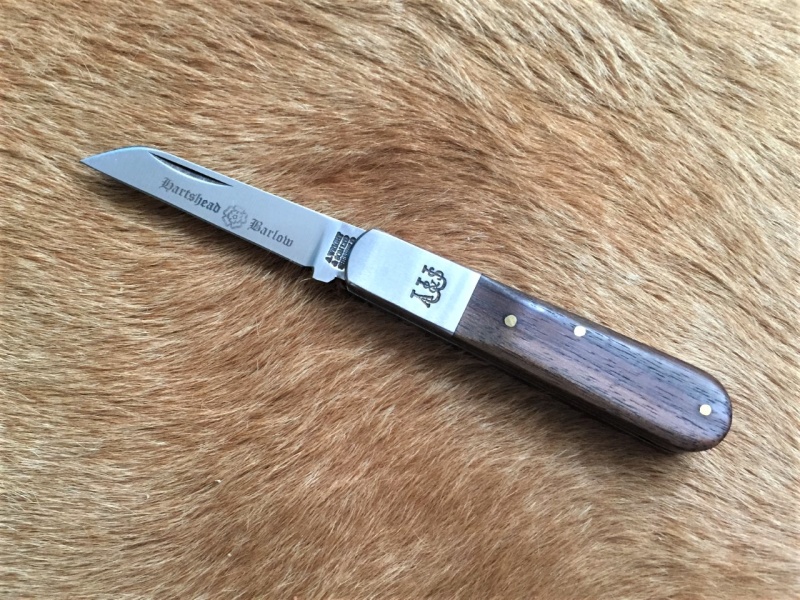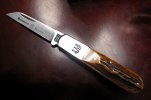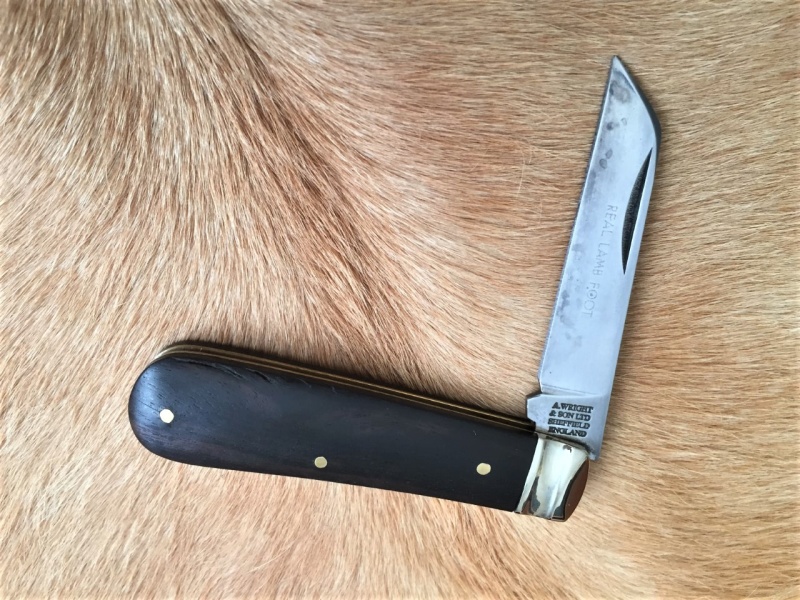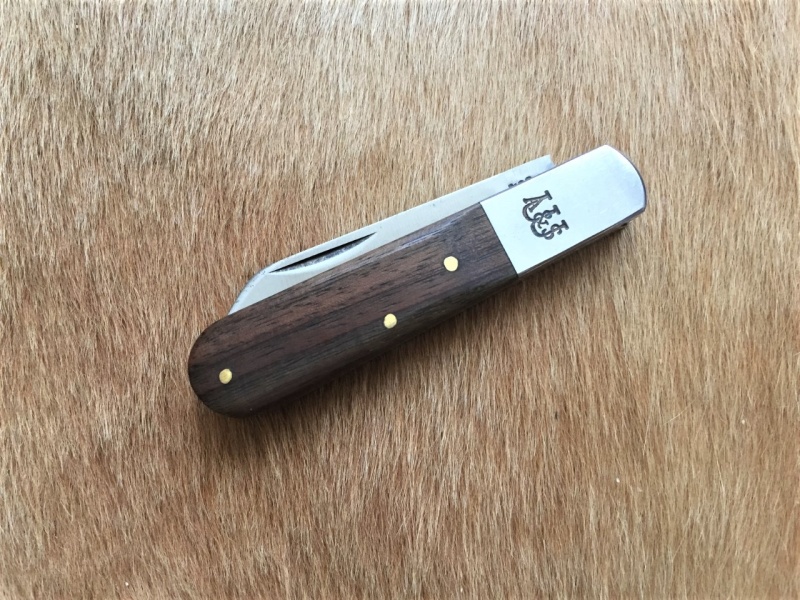Hi all! I'm writing an article on the Lambfoot and wanted to post it as plain text here first to see what you all thought. It seems clear that this thread is the premier destination for information on and aficianados of the Lambfoot knife, and I got much of the information in the article from this and other threads. Please let me know if you see any errors! (although I haven't edited for spelling / grammar yet) I appreciate you reading and hope its a good summary.
Also, if I were to buy a U.K. made Lambfoot, which could I expect to be of better quality, a Joseph Rogers in Buffalo or a George Wostenholm in Rosewood? They're the same price on the site I'm looking at and both covers look nice. I've never had a horn covered knife, and don't currently have any rosewood in my collection / rotation. Thanks!
What is the Lambfoot knife?
The Lambfoot is a knife that not many are familiar with, and that can seem a little vague, so what is it? The Lambfoot is defined primarily by its blade shape. It has a straight edge, with no belly (before sharpening / wear). The spine is straight, but angled slightly downward from the handle toward the tip. The main spine section comes to a rounded angle that connects a smaller, also straight, spine section to the tip. Aside from the blade, a Lambfoot knife usually has a swayback type handle. That means that the butt of the knife sets out of center with the pivot to the spring side. So considering all that, the Lambfoot is similar to a harvester, pruning, or cotton sampler knife with a more slender blade and (typically) more slender handle.
Where did the name and design come from?
The origin of the Lambfoot's name and design is murky and difficult to nail down definitively, but there are a few things that can be identified with some research. First, the pattern seems to have emerged in the mid to lade 19th century. There are no obvious examples of the Lambfoot in
Smith's Key 1816, an industry pattern catalogue. That said, there are some knives that seem to be Lambfoot predecessors that blur the line between Sheepfoot and Lambfoot. Another indicator that the pattern didn't develop until the late 19th century is that it didn't show up in America after many Sheffield cutlers immigrated to New England in the 1840s-1860s, which I'll discuss further later in the article. Manufacturer catalogues from the late 19th century begin to show Lambfoot knives, and their representation in catalogues becomes widespread in the early 20th century. Around this time the cutlery industry in the UK saw many trademark infringement lawsuits and both the design, as a modified sheepfoot, and the name could have been an attempt at marketing and product differentiation. Some evidence for this is the commonness of Lambfoot knives having a stamp or etch on the blade announcing that it's a "Real Lambfoot Knife". Specifically, it might have been called the Lambfoot because it is a more slender Sheepfoot, therefore playing on the fact that a Lamb is a juvenile Sheep. Aside from the Lambfoot being developed as a modified Sheepfoot to drum up marketing and sales, it could have developed as a more refined version as the needs of the UK cutlery market shifted less from farming and more to manufacturing which would require less of a robust blade. While these are some of the possible reasons that the name and design of the Lambfoot developed, it seems the original sole creator of the name and pattern have been lost to history.
Why is the Waynorth Lambfoot from GEC so special?
So, why did Great Eastern Cutlery's version of the Lambfoot knife make such a splash? It was one of the most anticipated and sought after knives in GEC's history, which is full of highly anticipated and sought after knives. It was produced alongside a normal run of a new pattern for GEC, the #93 Ramfoot, as a Special Factory Order for Waynorth Cutlery. Waynorth Cutlery is the new brand created by Charlie Campagna, the mastermind behind the TC Barlows, Harness Knives, and other great SFOs manufactured by Great Eastern Cutlery in recent years. Considering its popularity in the UK, it might come as a surprise that the Waynorth Lambfoot seems to be the very first factory produced Lambfoot knife made in America. Although I've heard that there might have been a Lambfoot made by an American manufacturer, I can't find an image showing an actual example. So after around 100 years of existence, the Lambfoot pattern finally made its debut American style.
Why didn't the lambfoot show up in America till now?
So, why did it take so long for an American company to make their version of the Lambfoot knife? As I mentioned earlier, one reason may be that many of the cutlery who founded the early American knife manufacturers immigrated to the United States in the mid 19th century, and the Lambfoot wouldn't be "invented" or come to prominence till the late 19th and early 20th century. However, the many blade shapes that became popular in America (Spear Point, Clip Point, Pen, Pruner, and Sheepfoot) had already been well established by the time the American cutlery industry was founded. Another barrier that may have kept the Lambfoot from being introduced into the U.S. market was the "McKinley" Tariff Act of 1890. This legislation brought the tax on imports to the U.S. to ~50% in some cases, and would have made Sheffield / U.K. manufacturers turn away from the American market. This turn away from the U.S. market is also likely why the Lambfoot knife can be found in Australia (especially considering its high amounts of sheep herders), and even somewhat in Canada, both once U.K. colonies. Also, the blunted tip of the Lambfoot is better suited for use in water related jobs. Sailors and others who work on the water tend to prefer a less pointed tip, as it makes accidental stabs of a sail (or sailor) less likely and less serious. Being an island nation, the percentage of people who worked on the water in the U.K. in the late 19th and early 20th century would have been (and likely still is) much higher than that of the U.S., making such blade shapes more in demand. Finally, curved edges are more useful in skinning, hunting, and general outdoors / wilderness tasks These types of tasks would have been much more common in America at the turn of the 20th century, when much of the country was still wilderness (whereas much of the U.K. was urbanized or farmland). Also, hunting was (and remains) much more common in the U.S. because there is more large game the the Americas. Additionally, hunting is illegal in many places in the U.K. because of an interesting history of the game being owned by the royal family and aristocrats. So, historical trends of industry, legislation, recreation, and immigration all seem to have likely played a part in the lack of Lambfoot knives made in America.
Conclusion
The Waynorth Lambfoot has become one of my favorite knives. In fact, it was one of my most carried knives of 2020 and has become a great user. It has also inspired me to look into U.K. made Lambfoot knives and, although they seem somewhat difficult to get from U.S. sellers, I plan to add one to my collection in 2021. I have also enjoyed researching the pattern's history, as it's always a pleasure to see how closely the story of knives weaves right into the overall current of history. I hope you've enjoyed this look at the history of the Lambfoot pattern.
Afterword
This article has been a long time coming. I have had several people request an article and / or video on the pattern, and I hope I've done the requests justice. Much of the information behind the content of this article was found in the
Guardians of the Lambfoot thread on BladeForums, as well as some on
All About Pocket Knives. I greatly appreciate all the knowledge that can be found on those sites and the help I've received from members over the years. One of the chief reasons I wanted to publish an article on this subject is because there really are few sources of information online about the Lambfoot other than those threads, and they can be somewhat difficult to navigate due to the sheer volume of posts. I hope this article is enlightening and helpful!




 . Indoor photography is the order of things. Back to carrying my HHB.
. Indoor photography is the order of things. Back to carrying my HHB.


















